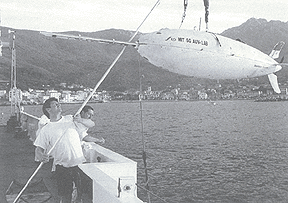
|
Archives:
Spring 2000 Table
of Contents The autonomous underwater vehicle (AUV) Odyssey has voyaged around the world: to the Arctic and the Antarctic, the Labrador Sea, the Mediterranean, and New Zealand's Kaikoura Canyon. But one of Odyssey's most important journeys was roughly half a mile–from the MIT Sea Grant AUV Lab to the headquarters of Bluefin Robotics Corp. Located across the street from the Cambridgeport Saloon, in an old auto parts building, Bluefin is the small start-up company that licensed the technology developed at the AUV Lab. That technology transfer is a critical component of bringing the lab's pioneering vehicles into the marketplace–and into the oceans. Back in 1990 when the Lab got its start, AUVs were large, million-dollar contraptions. But MIT Sea Grant director Chrys Chryssostomidis envisioned something different: sleek, economic robotic subs that would dive 6,000 meters and be readily lifted by two people (of average academic build). Within two years, AUV Lab manager Jim Bellingham and his colleagues had come up with Odyssey, a vehicle whose progeny have helped revolutionize the range and scope of AUVs. But commercializing even the best technology is a tricky proposition, explains Frank van Mierlo, Bluefin's commercial manager. "You can only transfer technology if you transfer people," he says. "In most success stories that means that people transfer out of academia. But academics don't always want to go into industry, and very often they aren't the right people to start up a new company." The alternative is to transfer industry people into an academic setting, and then transfer them back out into industry. This, says van Mierlo, has been the key to Bluefin's success thus far. "Chrys had the vision to bring people into the AUV Lab who could begin the transfer process," says van Mierlo, who spent two years as a research engineer with the Lab. "Those people then went into the company. It's a good model for MIT because the Institute doesn't want to lose its researchers."
According to van Mierlo, Bluefin's seven orders and its profitability set it apart in the AUV industry. "We've been profitable from the beginning and we have more than $3 million in order backlog right now," he notes. Those orders, from the Navy, The Scripps Institution of Oceanography, WHOI and U.K.-based Racal Survey Group Ltd., came after intensive work to discern the needs of both commercial and scientific sectors. Bellingham, who now works part-time at the Monterey Bay Aquarium Bay Research Institute and is technical director at Bluefin, notes that scientists in academia with limited budgets will often go to sea with systems that require tweaking. The time spent perfecting the system in the field is a cost-effective means of arriving at a satisfactory system. However, in the oil and gas industry,
a system must work as soon as it gets into the field. For instance,
if an oil company is surveying the sea floor before spending hundreds
of millions of dollars to erect an underwater platform, it needs
reliable survey instruments that won't hold up a schedule. However, such ROV work is expensive at great depths. AUVs, on the other hand, can be equipped with the necessary instruments and complete their tasks at a fraction of the cost. Racal has ordered two AUVs that it plans to use for shallow and deep water surveys for the oil and gas industry, cable inspection, dredging, alluvial mining, and military applications. Bluefin has already delivered one AUV to Lockheed Martin Corp. for use in mine countermeasures. The next AUV, a general research vehicle, will go to Scripps this spring and sport all new software, navigational equipment, and refined computational abilities. In August the company will deliver two AUVs for the Navy, which plans to use them to search for mines. According to Bellingham, the 1991 war with Iraq showed that "very simple mines almost brought oil shipping to a standstill. The Navy didn't have the techniques needed to find and clear those mines." With the new AUVs, they will be able to hunt down mines via broad area surveys of shallow water regions. Bluefin also will be building a vehicle for a project led by WHOI researcher Robert Sohn. In that effort, the AUV will be deployed by an icebreaker in the Arctic to collect seismology data from the ocean floor. While Bluefin's dozen full-time and three part-time employees busily work on filling their orders, the AUV Lab is focusing on developing new research, using AUVs for fisheries and educational purposes. "We're pushing out operations to Bluefin and keeping the core research capability within Sea Grant," says Chryssostomidis. "MIT's philosophy is that you help an idea grow and then once it reaches a certain level of maturity, you want it to go out and stand on its own. This is very important because our primary mission is to educate students and provide research opportunities." And undergraduates, he adds, are forever fascinated by robots. |
